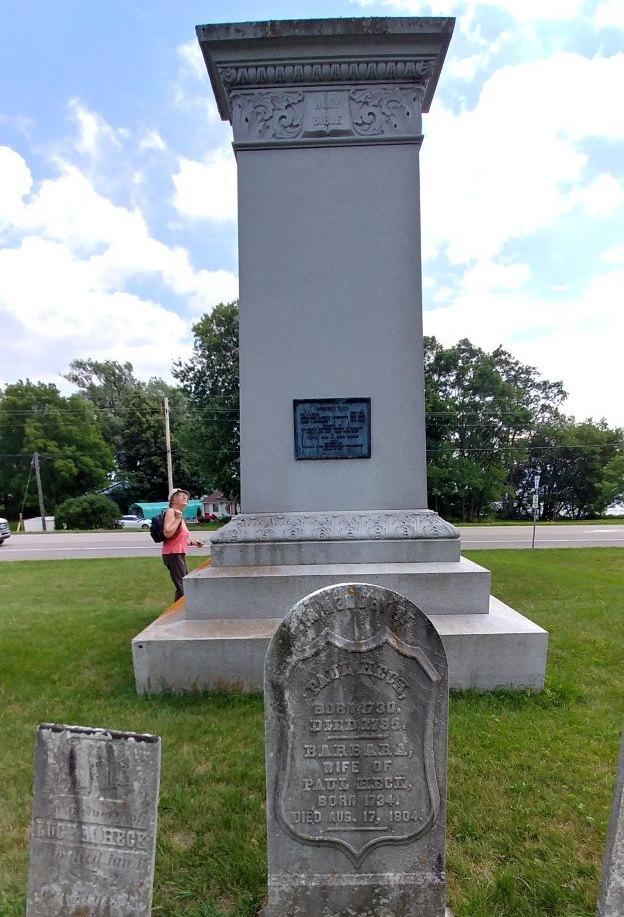A H Harry Oussoren • March 30, 2021
A Passion for Education

Grave and monument, near Prescott, to honour Barbara Heck, United Empire Loyalist and a strong mother of Methodism in Upper Canada (Ontario) (1734-1804). More about Heck & the EULs at a previous blog post: https://www.minister.ca/cemetery-learnings
~ ~ ~ ~ ~ ~ ~ ~ ~ ~~
Historical Bottom Lines
Just finished reading Kenneth H. Cousland’s The Founding of Emmanuel College in Victoria University of the University of Toronto!* It didn’t just roll off the presses. It was published in 1978 – a decade after I graduated from Emmanuel and 50 years after the College was established. I wish I’d read the book sooner. I would have been better informed about the evolution of the Church and its theological schools. It should be required reading for all Emmanuel students, especially UCC members.
Two things stand out clearly upon reading this loving account of the evolution of theological education in Ontario and the creation of Emmanuel College which Cousland served as professor of church history and as its third Principal. First, the importance our foreparents accorded education - in general - for the well-being of society, and theological education, in particular, for the church to participate faithfully in God’s world. It is a large legacy they bequeathed to us. The second is that education to be sustainable and effective requires ongoing substantial investments of vision, determination, cooperation, and money.
Wandering towards Church Union 1925
So, now you can now just put this blog post aside since you’ve gotten the bottom lines or you can wander with me toward the founding of Emmanuel College substantiating these two primary learnings. This post leads you up the path to Church Union in 1925. A subsequent post will take readers into the aftermath of Union.
Cousland’s slender volume is an personal account offering a glimpse into the development of Protestant education in 19th century Upper Canada and some of its key players. Little schools popped up here and there in the semi-wilderness, then merging into larger schools in towns and cities. The aim was to better serve basic educational needs of the growing settler populations coming as immigrants from the British Isles and United Empire Loyalists fleeing the American Revolution and War of 1812. [See my blog post on Barbara Heck at https://www.minister.ca/cemetery-learnings.] Regrettably, nothing is said about Indigenous peoples response to this invasion, nor about the role women played in shaping the educational enterprise.
Methodist Initiatives
Providing education is easier said than done! The United Church’s antecedent denominations struggled with the establishment pretensions of the “Church of England” leadership and the “Family Compact” political elite. There was little room for nor encouragement of educational opportunity for other than Anglicans.
Methodists, though, at the 1830 Conference, decided education was as much a necessity as religious practice was for the general population and determined to create an educational institution.
The Upper Canada Academy - “a purely literary institution” – was finally founded and formally opened on June 18, 1836 with 120 students. Its aim was to provide “a general liberal arts education for students of all denominations without any religious tests either for professors or students. It was to have ‘a religious character yet not sectarian, liberal in its view yet not radical, maintaining the highest academic standards yet not exclusively confined to one type of education.’” (Cousland, p. 22)
Raising funds to build a home for the Academy was a heroic cause evoking generosity and sacrifice - evidence of the popular enthusiasm for the educational vision, especially among Methodists. Financial crises abounded, however. One threatened to imprison building committee members who had pledged personal resources. Another moved fifty itinerant preachers to sign an amazing pledge for half their meager salaries. (p.23)
To get around establishment obstructions to granting the Academy a charter, Egerton Ryerson was personally mandated by the Conference to sail to London to seek a charter mandating the provision of instruction “in the various branches of Literature and Science on Christian principles.” He was successful. King William granted the Royal Charter in October 1836 - the first such charter issued to a non-Anglican institution outside the British Isles.
In the early 1840s, the decision was made to transform the Academy - a secondary school - into a university. Ryerson’s further efforts were again successful - this time, in having the Royal Charter appended to an act of the Upper Canada Legislature elevating the Academy to college level and giving it the name “Victoria College.” Ryerson became the first Principal and college level liberal arts classes began in October of 1842. Educational options were expanded subsequently: 1854, Medicine; 1860, Law; and a Bachelor of Science degree in 1875. In the early 1870s theological courses began to be offered. In 1873, Theology was elevated from department to faculty status with Professor Nathanael Burwash as dean.
Methodist church bodies of diverse origins realized their fragmentation did not contribute to effective ministry. In 1884, they united into one Methodist Church and decided to support one University: Victoria University. The next step was taken In 1886, when Victoria federated with the University of Toronto. Victoria continued its Arts program including Religious Knowledge, relinquished law and medicine, but retained its Faculty of Theology.
Presbyterian Initiatives
East of Coburg in Kingston, Scottish Presbyterians had founded Queen’s College. Unlike Victoria, Queen’s began as a theological school to which subsequently an Arts faculty was added. Conflict in Scotland between the supporters of the national established Kirk and those advocating a Free church spilled over into the colony. The disagreement played out with “Free” supporters in 1844 launching another seminary – this time in Toronto. Eventually it was chartered by provincial legislation as Knox College. In 1875, Knox College occupied a newly built home on Spadina Circle serving the school for the next 40 years.
Gradually Toronto became the heavy weight centre for theological institutions in Ontario. The Presbyterian Church unified in 1875 maintained both Knox and Queen’s as theological schools. The Methodists decided to move Victoria University from "the old Ontario strand" of Coburg to the Queen’s Park circle campus in 1892. It provided education for Arts students and a smaller number of theologs. Roman Catholics were part of the University through St. Michael’s College and Trinity (Anglican) federated later.
By 1915 the Knox premises had worn out. The building was replaced by a handsome new structure on the St. George campus next to University College, upon which Presbyterians relied for Arts education. The persistent fund-raising labours of Principal Alfred Gandier had been crucial to realizing the shared vision of a new facility to serve the new denomination’s need for substantial theological education. Responding to the Unionist movement, leadership in both Knox and Victoria’s Faculty of Theology had been implementing strategies that increased cooperation and shared teaching as intentional steps toward eventual amalgamation.
Union is at Hand
Everything appeared ready for the new united church to have a central capacity for theological education at the Knox building. It implied that Victoria’s Faculty of Theology would be woven into the Knox operations – a sacrifice of significant proportions for Methodists. But it was felt that this was a cost justified by the new united denomination’s need for informed and competent “learned” leaders. Victoria would continue as the new denomination’s primary Arts university in Ontario among whose graduates candidates for ministry would pursue theological studies across the campus at Knox.
Strong leadership, close collaboration, generous giving, and prayers for unity had set the stage for a new and vital era in education among Protestants in Ontario and Canada as a whole.
What could possibly go wrong? Stay tuned for the next post…….
~ ~ ~ ~ ~ ~ ~ ~ ~ ~ ~ ~ ~
[see my previous blog in this series: https://www.minister.ca/cultivating-theological-leadership
*Kenneth H. Cousland, The Founding of Emmanuel College of Victoria University in the University of Toronto. The Porcupine’s Quill, 1978.

